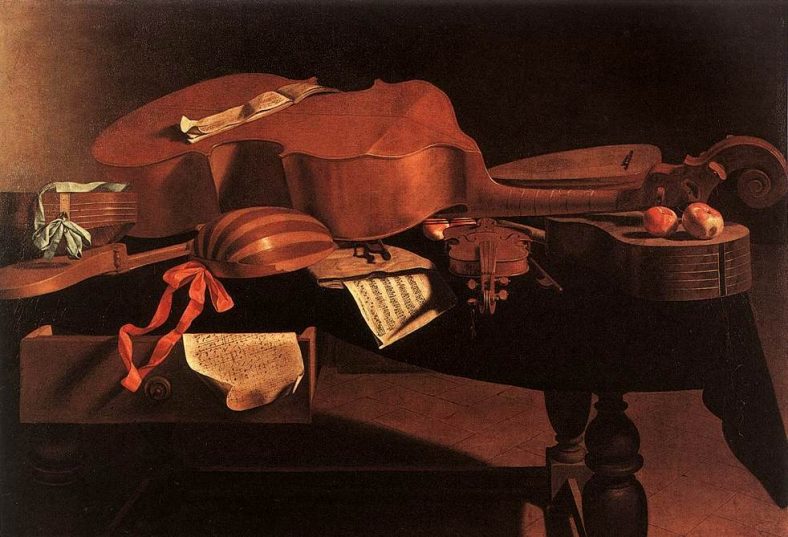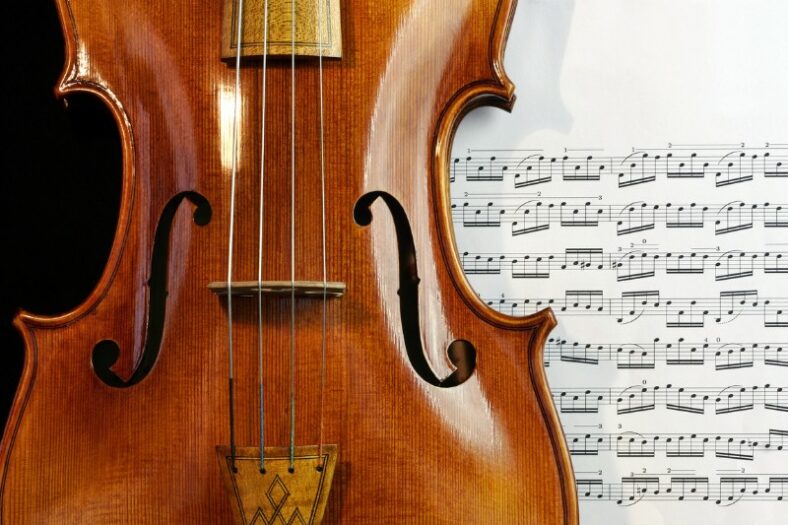Characteristics of Baroque Music

The Baroque music period was between 1600 and 1750, after the Renaissance. It was characterized by contrast, layered melodies, monody, dynamics, and ornamentation. It also aided the rise of instrumental music.
The Baroque period saw a significant development of the musical norms and traditions that were previously known. The expanding acceptability of non-sacred instrumental music fostered invention and experimentation. This meant that ensemble sizes got bigger.
Instrumentation became more specific, composers specified which instruments should be used and when. It was during this period that compositions got more complex. Additionally, the impact of Italian opera introduced fresh drama onto the European musical scene.
Contents
Characteristics of Baroque Music – At A Glance
- Contrast. This played a huge role in Baroque music. Composers often experimented with contrast in their compositions, frequently employing changes from soft to loud, solo to group, change in instrumentation, and movement shifts.
- Layered Melodies. This method was used to create more depth in a composition. Having two or more simultaneous melodies being played in a different row created a counterpoint effect, hence adding complexity and character.
- Monody. In contrast to the counterpoint technique, Monody involves a single voice singing a free melodic line extravagantly with harmonic assistance. Composers often included simple and accompanied recitations as well, which slowly evolved into what we know today as Opera.
- Dynamics. Dynamics represented a huge part of Baroque music. The sudden change in volume degrees was due to the harpsichord which had rapid dynamic shifts. However, with the coming of the piano, this did not last very long.
- Ornamentation. Ornamentation such as trills, mordents, turns, grace notes, complex arpeggios, scale patterns, and passing tones were frequently demanded by composers and dictated as well since dynamics weren’t as rich back then.
Notable Baroque Composers
- Claudio Monteverdi
- George Frideric Handel
- Johann Sebastian Bach
- Antonio Vivaldi
- Henry Purcell
Instruments Used in Baroque Music
- Strings: Lute, violin, cello, double bass
- Wind: The recorder, flute, oboe, bassoon
- Brass: Horns, trumpets
- Percussion: Timpani
- Keys: Organ, harpsichord
Characteristics of Baroque Music
1. Contrast
Contrast, as an essential dramatic element, was employed to express the meaning of the text. This was done by the change of instrument numbers or with the change of movements, in the Baroque style.
During the Baroque period, composers experimented with contrasting musical styles. As you can imagine, they were vastly different from the music of the renaissance period. Tonality was subdivided into two categories: Major and minor.
Throughout many Baroque pieces, certain characteristics played a vital part. This included contrasts between loud and soft, solo and group, different instruments, and timbres.
During a Baroque piece, especially in a concerto, you can hear many passages played by a single instrument. This was mostly done by the soloist. Next, followed by the same sections played by the entire ensemble. As a result, there is a lot of drama.
There has also been discussion about shifting movements. Even though that difference is crucial between movements in Baroque compositions, one continuous mood, and rhythmic pulse dominate. They aim to elicit one distinct emotional reaction, which is often called “The Doctrine of Affections”.
In other words, each segment contains a single emotion or mood that does not shift throughout the run of the song. Instead, it simply stays inside a particular mood. To establish a new mood, the song must be finished and a new mood for a new song must be developed.
2. Layered Melodies

Layered melodies were commonly used in Baroque works. This meant that two or more melodies would simultaneously follow each other in a different row. This created a counterpoint effect.
When two or more melodies are layered in Baroque style, they have their rhythm and contour. Additionally, they have to work together to make a harmonious sound. There are many examples of it in Western music and was known as the counterpoint technique.
Music composition became more complicated during this period. This resulted in a vertical alignment of tones with specific harmonic meanings. The usage of triads became an important aspect of tonality. This, in turn, offered an auditory basis or basic key known as the tonic.
The system of Major and minor key centers developed throughout the Renaissance. This was done through experimentation in tuning and interval alteration, and the creation of specific harmonic theories. However, the tonality further evolved from the use of layered melodies in Baroque music.
3. Monody
Monody in Baroque music is a solo voice singing a free melodic line extravagantly. It came from an attempt by the Florentine Camerata in the 17th century to revive old Greek ideals about melody and declamation.
In the Baroque period, no composer used the term “monody” to describe a piece of music. Music was slowly turning homophonic. This meant that it was based on a single melody with harmonic assistance provided by a keyboardist.
Today’s term “monody” in music refers to a type of single (mono) voice characterized by one melodic line and an accompanying musical backing. This new monodic style was first used by the Florentine Camerata and a few others. They used this style for composing madrigals, motets, and even concertos.
Contrary to the polyphonic tendency to obscure the meaning of texts, composers strove to develop a new musical style. This new style was more expressive and connected to the text’s original lyrics. People started using this new monodic style, which evolved into early opera.
Composers put more emphasis on correct articulation and expressive interpretation of emotional texts. Additionally, simple accompanied recitation was used instead of the counterpoint technique. So, they employed a melodic soprano line, with an accompanying bass line, to create their music. In both vocal and instrumental compositions, Baroque polyphony is split up into treble and bass parts.
By following the harmonic numbers placed above the bass part, the soloist was free to sing or play any note. To make harmony and melody work together, basso continuo (continuous bass) became more prevalent. This was due to the popularity of monodic style instrumental music and Italian opera.
4. Dynamics
Sudden changes between the extreme volume degrees (terraced dynamics) are also important characteristics.
The musical accompaniment relied on the harpsichord which had rapid dynamic shifts. This was due to the instrument’s inability to crescendo or decrescendo between loudness and softness. Singers, instruments, ensembles, and even orchestras followed these dynamics by copying the harpsichord.
With the invention and development of the piano, this musical tradition didn’t last long.
5. Ornamentation
Ornamentation was an extensive characteristic of Baroque music. This was because the dynamics weren’t as rich at the time.
For centuries, composers dictated every note to classical musicians. It was common practice for composers of the Baroque era to demand embellishments. This included ornamentation such as trills, mordents, and turns. The ornamentation also encompassed grace notes, complex arpeggios, scale patterns, and passing tones.
The usage of vibrato was also seen as a decorative element. It was intended that the artists would also improvise, particularly on cadences.
For ages, ornaments have played an important part in music. This was due to the ambiguities in their notation and the fact that they were sometimes omitted from the score.
Notable Baroque Composers
Many notable composers contributed to the Baroque period of music, and not surprisingly so, most of them hailed from Italy. Here are a few:
- Claudio Monteverdi. Monteverdi was a key composer in the transition between the Renaissance and Baroque periods of music. He helped the development of opera music, and although many of his work was lost, he has remaining operas and other works.
- George Frideric Handel. A German-British composer responsible for many famous works like operas, sonatas, oratorios, arias, concerti grossi, and organ concertos. He helped bring opera to its glory and brought about a new style of English church music. His most famous work is “Messiah”.
- Johann Sebastian Bach. Born in Germany, Bach was known for his Brandenburg Concertos, Cello Suites, Concerto Grosso, and the organ Toccata and Fugue in D minor. Hailing from a family of composers, it’s no shock that Johann followed in their footsteps, eventually becoming a vital figure in Baroque music.
- Antonio Vivaldi. Along with the aforementioned composers, Vivaldi also ranks as one of the pioneering composers of the Baroque era. He was the face behind pioneering developments in orchestration, violin technique, and programmatic music.
- Henry Purcell. Considered among the greatest English opera composers, Purcell contributed heavily to the success of the Baroque period of music. He had numerous works published, everything from sonata to cantata to odes.
Instruments Used in Baroque Music
The Baroque orchestra was a modest group of musicians, known as a chamber orchestra. The harpsichord and organ were keyboard accompaniment instruments besides cello and bass.
Lute, violin, cello, and double bass are examples of stringed instruments.
The recorder, flute, oboe, and bassoon were among the most popular wind instruments.
Horns and trumpets were popular brass instruments of the era.
Timpani was employed in the percussion section in the Baroque orchestras.
The organ and harpsichord were popular keyboard instruments in the Baroque period.
Summary
Characteristics of Baroque music show the transition from Renaissance music to Classical. The contrasts show up in almost every aspect of the compositions. This is because drama is one of the keywords synonymous with the word Baroque (the Portuguese word for ‘Broken Pearl’), except for the mood, the mood stays the same during a piece.
Layered melodies have an important role in the evolution of tonality. We also see the sudden contrasts in dynamics because of the nature of the harpsichord. The ornamentations, however, were helping to keep the music more interesting.





